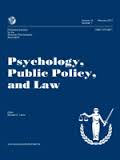 Social environment and antisocial influence of peers may play a role in explaining the impact of psychopathic traits in juveniles. This is the bottom line of a recently published article in Psychology, Public Policy, and Law. Below is a summary of the research and findings as well as a translation of this research into practice.
Social environment and antisocial influence of peers may play a role in explaining the impact of psychopathic traits in juveniles. This is the bottom line of a recently published article in Psychology, Public Policy, and Law. Below is a summary of the research and findings as well as a translation of this research into practice.

Featured Article | Psychology, Public Policy, and Law | 2016, Vol. 22, No. 1, 92-104
The Importance of (Anti)Social Influence in Serious Juvenile Offenders With Psychopathic Traits
Authors
Joseph R. Tatar II, University of California, Irvine
Caitlin Cavanagh, University of California, Irvine
Elizabeth Cauffman, University of California, Irvine
Abstract
Psychopathy, as it is popularly conceptualized, includes personality features (callousness, lack of remorse or shame, manipulativeness, and pathologic egocentricity) which imply impediments to the formation of traditional social bonds. However, it has been suggested that individuals with psychopathic traits may be affected by their social context, which may fuel their engagement in antisocial activity (Kerr, Van Zalk, & Stattin, 2012; Martens, 2002, 2003). As adolescents are inherently more susceptible to social influences than other developmental stages, it is especially important to understand the role of interpersonal context, particularly among youth with psychopathic traits. This study examines whether psychopathic traits moderate the relation between the antisocial influence of peers, parents, and very important nonparental adults on institutional (both self-report and official records of) offending in a sample of serious juvenile offenders in Southern California. Results indicate that greater exposure to antisocial influence from peers and very important nonparental adults translated to more delinquent behavior among all youth in the current study, but the impact of peer influence on institutional misconduct were particularly pronounced for youth high in psychopathic traits. These findings imply that taking a youth’s social environment into account is paramount when examining the importance of psychopathic traits to adolescent antisocial behavior.
Keywords
psychopathy, juvenile offenders, antisocial influence, antisocial peers, very important nonparental adults
Summary of the Research
“Relative to adults, adolescents differ in their psychosocial maturity and the importance they place on the interpersonal context. Adolescent behavior (particularly antisocial behavior) is greatly affected by interactions with peers, parents, and other adults. Adolescents are also more susceptible than children and adults to social influence from peers and nonparental adults; compared with adults, adolescents are more likely to engage in risky behavior when in the company of their peers. Psychopathic traits must be examined within this developmental context in order to understand how these traits manifest in adolescence” (p. 92)
“Popular conceptualizations of psychopathy include personality features (e.g., callousness, remorselessness, manipulation) that may impede the formation of traditional social bonds. This suggests that individuals with psychopathic traits, due to their tendencies toward interpersonal dominance and lack of concern toward others, may be impervious to the effect of social influence. In other words, individuals with psychopathic traits present a higher baseline risk-state, due to their unwillingness to consider others when engaging in antisocial behavior. However, a contrasting theoretical perspective offered by Martens suggests that interpersonal relationships may play an important role in the emotional experiences and resultant behavior of individuals with psychopathic traits. Martens suggests that interpersonal relationships can indeed affect the situational risk-status of individuals with psychopathic traits by promoting or inhibiting behavior (antisocial or otherwise). However, empirical support for this postulation is limited. The present study examines whether psychopathic traits among serious juvenile offenders affect the relation between the antisocial influence of peers and nonparental adults on institutional offending” (p. 92).
“It is well established that associations with delinquent peers influence youth engagement in antisocial behavior. Peer influence may occur through a transactional process, such that youth’s antisocial behavior is not only influenced by peers, but youth may also affect their peers’ antisocial behavior or seek out youths who are supportive of delinquent behavior. Yet, peer influence alone (beyond selection effects) may also prompt adolescents to engage in antisocial behavior” (p. 93).
“In addition to peers, many adolescents look to nonparental adults for guidance, support, and behavioral modeling (termed VIPs within the literature). VIPs, or natural mentors, are adults with “significant influence” on an adolescent who can be counted on for support. The VIP–adolescent relationship is qualitatively different than other types of social influence; VIPs represent nonjudgmental role models, a combination of both of peer and parental qualities. About 83% of female and 68% of male adolescents report having a VIP in their life, demonstrating that these relationships are a common source of social influence for adolescents” (p. 93).
“In the general population, the story is clear: Adolescence is a developmental period of heightened social influence from peers and VIPs. Because the social context is salient, adolescents are at an increased risk for antisocial behavior when their social environment supports such behavior. Less clear, however, is how this developmental phenomenon can be reconciled with the literature on psychopathy. If the construct of psychopathy can be directly extended downward from adults to adolescents, perhaps social influence has no bearing on adolescents with psychopathic traits (unlike their community counterparts). Conversely, if youth with psychopathic traits are similar to adolescents without these characteristics, perhaps the developmental context renders social influence just as important to both groups of youth. In other words, do adolescents with psychopathic traits behave like adolescents without psychopathic traits in terms of their receptivity to antisocial influence?” (p. 93 – 94).
Translating Research into Practice
“Relative to adults, adolescents differ in their psychosocial maturity and the importance they place on the interpersonal context. Adolescent behavior (particularly antisocial behavior) is greatly affected by interactions with peers, parents, and other adults. Adolescents are also more susceptible than children and adults to social influence from peers and nonparental adults; compared with adults, adolescents are more likely to engage in risky behavior when in the company of their peers. Psychopathic traits must be examined within this developmental context in order to understand how these traits manifest in adolescence” (p. 92)
“Popular conceptualizations of psychopathy include personality features (e.g., callousness, remorselessness, manipulation) that may impede the formation of traditional social bonds. This suggests that individuals with psychopathic traits, due to their tendencies toward interpersonal dominance and lack of concern toward others, may be impervious to the effect of social influence. In other words, individuals with psychopathic traits present a higher baseline risk-state, due to their unwillingness to consider others when engaging in antisocial behavior. However, a contrasting theoretical perspective offered by Martens suggests that interpersonal relationships may play an important role in the emotional experiences and resultant behavior of individuals with psychopathic traits. Martens suggests that interpersonal relationships can indeed affect the situational risk-status of individuals with psychopathic traits by promoting or inhibiting behavior (antisocial or otherwise). However, empirical support for this postulation is limited. The present study examines whether psychopathic traits among serious juvenile offenders affect the relation between the antisocial influence of peers and nonparental adults on institutional offending” (p. 92).
“It is well established that associations with delinquent peers influence youth engagement in antisocial behavior. Peer influence may occur through a transactional process, such that youth’s antisocial behavior is not only influenced by peers, but youth may also affect their peers’ antisocial behavior or seek out youths who are supportive of delinquent behavior. Yet, peer influence alone (beyond selection effects) may also prompt adolescents to engage in antisocial behavior” (p. 93).
“In addition to peers, many adolescents look to nonparental adults for guidance, support, and behavioral modeling (termed VIPs within the literature). VIPs, or natural mentors, are adults with “significant influence” on an adolescent who can be counted on for support. The VIP–adolescent relationship is qualitatively different than other types of social influence; VIPs represent nonjudgmental role models, a combination of both of peer and parental qualities. About 83% of female and 68% of male adolescents report having a VIP in their life, demonstrating that these relationships are a common source of social influence for adolescents” (p. 93).
“In the general population, the story is clear: Adolescence is a developmental period of heightened social influence from peers and VIPs. Because the social context is salient, adolescents are at an increased risk for antisocial behavior when their social environment supports such behavior. Less clear, however, is how this developmental phenomenon can be reconciled with the literature on psychopathy. If the construct of psychopathy can be directly extended downward from adults to adolescents, perhaps social influence has no bearing on adolescents with psychopathic traits (unlike their community counterparts). Conversely, if youth with psychopathic traits are similar to adolescents without these characteristics, perhaps the developmental context renders social influence just as important to both groups of youth. In other words, do adolescents with psychopathic traits behave like adolescents without psychopathic traits in terms of their receptivity to antisocial influence?” (p. 93 – 94).
Present Study
Utilizing a sample of 373 adolescent males between the ages of 14 and 17, “the present study examines whether psychopathic traits moderate the relation between antisocial influence by peers and non-parental adults and lifetime and institutional offending among a sample of incarcerated juvenile offenders” (p. 94). The youth in the current study were incarcerated in a juvenile facility in Southern California and the racial/ethnic composition of the sample was diverse; the majority of these adolescent males were convicted of a violent person offense (70%). The adolescences in this study “participated in a 2-hr baseline interview within 48 hours of their arrival to the facility. Follow-up interviews (90 min each) took place weekly for the subsequent 3 weeks, with a monthly follow-up thereafter. Interviews were conducted in-person at the youth facility by trained graduate and undergraduate students. All research staff involved in the data collection participated in multiple training sessions prior to working on the project” (p. 95).
This study used the Youth Psychopathic Trait Inventory (YPI) to assess psychopathic traits. The Peer Delinquent Behavior Scale was administered to assess the influence of parents, peers, and VIPs’ engagement in and support of antisocial behavior. Lastly, to assess the youth’s involvement in antisocial and/or illegal activities, a modified version of the Self-Report of Offending scale (SRO) was administered. Moreover, since reports of offending behavior were obtained though a self-report measure, the researchers reviewed institutional records from the first two months the youths were incarcerated. These official records were used in combination with the individual’s self-report in hopes of maximizing the validity of the information obtained from the SRO.
Results
“The goal of the present study was to determine whether the relation between social influence (from peers and VIPs) and antisocial behavior varied as a function of youths’ psychopathic traits. The results revealed several key findings. First, the antisocial influence of both peers and VIPs increased adolescent offending behaviors, both prior to incarceration as well as within the facility. Youth exposed to more antisocial influence were more likely to offend, regardless of their degree of psychopathic traits. In most cases, the relation between antisocial influence and offending behavior was not moderated by psychopathic traits. Finally, while the impact of peer antisocial influence appeared to depend on psychopathic traits for self-reported institutional offending, the impact of peer influence was stronger for youth higher in psychopathic traits. In other words, relationships with antisocial peers resulted in more antisocial behavior for youth with higher levels of psychopathic traits compared to youth with lower levels” (p. 100)
“The present study considers multiple antisocial influence styles (behavior vs. direct influence) and multiple sources of influence (peers, parents, and VIPs). Results suggest that a more nuanced understanding of the impact of the interpersonal context on juvenile delinquency is warranted. First, though peers and VIPs can independently influence an adolescent’s offending, parental effects overshadow other interpersonal influences, even when youth do not reside in the home (e.g., while incarcerated). However, when actively surrounded by one’s peers and VIPs (e.g., within the community), the influence of extrafamilial contacts are robust, and outweigh parent effects. Second, the present study revealed different patterns in the way peers and VIPs tend to exert their influence. When considering peer effects, direct attempts to influence a youth’s behavior appear more important than simple exposure to peer antisocial behavior. In other words, the more a youth’s peers actively try to influence him, the more impact peers have on his behavior. In comparison, VIPs tend to have their greatest level of influence on adolescent offending behavior through modeling (e.g., their actual behavior) than through direct attempts to influence a youth” (p. 100).
Other Interesting Tidbits for Researchers and Clinicians
“It is important to identify developmental features (in this case, social influence) that may impact engagement in antisocial behavior for youth high in psychopathic traits so that targeted interventions may be applied. Understanding the importance of social relationships is essential when examining the form and function of psychopathic traits during adolescence” (p. 100).
“These findings carry important implications for the conceptualization of psychopathic traits in adolescence, as well as the treatment efforts targeting adolescent offenders. First, the construct of adult psychopathy should not be grafted to adolescence without consideration for the developmental context (in this case, susceptibility to social influence). As the field continues to study and define psychopathic traits and their implications for antisocial behavior in adolescence, it is critical to do so within the scope of the developmental context” (p. 101).
“The observation that the social environment can influence adolescent offenders with psychopathic traits strengthens the assertion that treatment strategies can be successful with this population. Like two sides of a coin, just as antisocial influence may support youths’ engagement in delinquent behavior, prosocial engagement may reduce it. Although our data were not designed to address prosocial influences, exposure to positive social influences may help to reduce delinquent behavior among youth with psychopathic traits. Interventions that address peer networks may be particularly effective with this population. For example, controlling the access of youth high in psychopathic traits to peers and VIPs who represent an antisocial influence may stem youth reoffending. VIPs are a special category of adult mentors; to the extent that adolescents model their behavior after VIP behavior, other adult mentors may positively impact youths’ lives. Specifically, mentorship programs (e.g., Big Brothers/Big Sisters) or counseling sessions could help youth find positive adult role models against whom to model their behavior.
Taken together, our results favor the study of psychopathic traits in adolescents through the lens of the developmental context. The presence of psychopathic traits does not negate the influence of the social environment on youths’ antisocial behavior. Instead, for youth both with and without psychopathic traits, the influence of their peers, parents, and very important nonparental adults can have a strong impact on their behavior. These findings challenge underlying assumptions attached to the psychopathy label with regard to treatment amenability and the subsequent stability of their expressed socioemotional characteristic. In addition, the expression of psychopathic traits may be less stable among youth than among adults in part because of youths’ heightened susceptibility to social forces relative to adults. As such, taking a youth’s social environment into account is critical when examining the psychopathic traits and adolescent behavior” (p. 101).
Join the Discussion
As always, please join the discussion below if you have thoughts or comments to add!





















